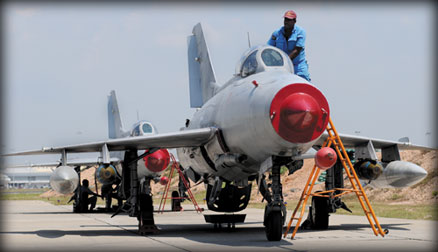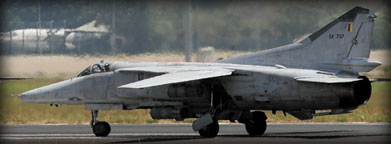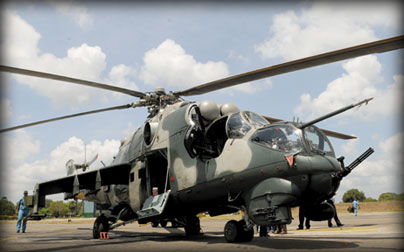The derring do of the Sri Lanka Air Force
By Dhaneshi YATAWARA
 |
|
A full check up on a
F-7 jet |
During the time we gained independence from the British in 1948 our
skies were secured by the Royal Air Force of Great Britain. The then
rulers of Ceylon immediately understood the grave need of having our own
security forces.
As history recalls, the Army, though they were essentially a British
Force, Ceylonese rose to Officer ranks in the Ceylon Light Infantry. The
Ceylon Royal Navy Volunteer Reserve was formed during World War II and
laid the foundation for the Royal Ceylon Navy at the time of
independence.
Then as the youngest of the family of Security Forces the
Royal Ceylon Air Force, predecessor of the present Sri Lanka Air Force,
was born on March 2, 1951.
Hence, the proud wings of our nation celebrate its 58 years in the
service of protecting our motherland at all times, especially during her
dark and gloomy periods.
“41 of 49”
With the presentation of Bill No. 41 in 1949, or better known as ‘41
of 49’ our country was to get wings to protect our skies. The Bill No.
41 was presented to Ceylon House of Representatives by R. G. Senanayake,
the Parliamentary Secretary to the Minister of Defence and External
Affairs on August 9, 1949.
The Bill provided for a Regular Air Force, A Regular Air Force
Reserve, A volunteer Air Force and a Volunteer Air Force Reserve. The
then Governor General Lord Soulbury ratified the Bill on October 3, 1949
completing the legislative work. Thus, the Air Force Act was born.
Unfortunately Ceylonese were not represented among the top brass of
the Air Force. Consequently, Prime Minister D. S. Senanayake sought the
assistance of our erstwhile rulers - the British - for assistance. In
fact, the British Government had already signed a Defence Agreement with
Ceylon, under the provisions of which the British were required to
furnish the Government of Ceylon, `Such military assistance as may, from
time to time be required, towards the training and development of the
Ceylonese Armed Forces.’
Thus, the British sent Group Captain Graham Clerke Bladon to set up
the Royal Ceylon Air Force (RCyAF) and command it. Bladon got down to
work from his quarters at the Galle Face Hotel with two secretarial
assistants.
Royal Ceylon Air Force
In consultation with the Permanent Secretary to the Minister of
Defence Sir Kandiah Vaithianathan and several other senior
administrative officers laid the foundation to set up the RCyAF. Then
from Galle Face Hotel, Group Captain Bladon and his staff shifted to
Rifle Green at Parsons Road, now known as Sir Chittampalam A. Gardiner
Mawatha. The first proper headquarters was established at Rifle Green.
Not having a support of a volunteer force or trained staff among the
Ceylonese Group Captain Bladon had to rely on the Royal Air Force. Thus,
he obtained Ministry of Defence approval to appoint several officers
from the RAF along with Wing Commander A. F. Dale as the Senior Air
Staff Officer.
First Ceylonese
 |
|
MI -17 deploying Army personnel at the
forward lines. Pix by Rukmal Gamage |
Among the first Ceylonese to be recruited as Officers were Squadron
Leader E. Rohan Amarasekara (Air Staff Officer), Flight Lieutenant R. B.
D. Jansen (Engineering Officer), Flight Lieutenant Ken Nagarajah
(Equipment Officer), Flight Lieutenant Wijendran (Secretarial Officer),
Flight Lieutenant P. G. Walpita (Education Officer) and Flight Officer
S. N. Samarasinghe (Secretarial Officer).
On August 8, 1951 Officer Cadets D.de S. Seneviratne and Paddy Mendis
were recruited to the RCyAF and were sent to Royal Air Force College,
Cranwell.
In the same year Fl. Lt. Nagarajah was assigned to select ten young
Ceylonese men for the vacancies of trainee pilots. They were Ivor de
Abrew, L. B. Tissa, R. Vartharasa, C.Chelvarajan, Mike Phoebus, D.
Nicolle, Dick C. Perera, R. Vivekanthan, Harry Goonetileke and Jayasena.
In later years L. B. Tissa died in a flying accident over Katugastota,
R. Vartharasa died in an accident flying over China Bay in a Dove
aircraft and Chelvanrajan lost his life in a crashing accident at
Katunayake in a Balliol aircraft.
The second batch included Flight Cadets A. Walter Fernando, L. W. A.
Christianz, E. Deryck Pereira, Johnpulle, T. Saldin, Milroy de Soyza, L.
Perera, R. Perera and Noel Anandappa.
Following in the footsteps of Paddy Mendis and Sene Seneviratne at
Cranwell were Flight Cadets S. V. Mahendra Situnayake, Nihal Ratnayake,
Denzil Perera and Sheehan Abeysinghe followed in later years by H.
Rajapaksha and Ralph Forbes.
As the history records, young Forbes, after qualifying at Cranwell
and returning to his motherland, crashed near Trincomalee while engaged
in some low level aerobatics in a Chipmunk aircraft.
The first two Ceylonese pilots at Cranwell, Paddy Mendis and Sene
Seneviratne graduated on April 6, 1954. The first batch of cadets also
passed out in 1954.
The Air Force began recruiting other grades and other disciplines as
well.
 When the RCyAF was formed in 1951, a priority was to recruit and
train local young men as aircraft technicians. The first Ceylonese
apprentice was Douglas Abeysekera from Kaluthara who later retired as a
Squadron Leader. Thus, the first chapter of true Sri Lankan identity
started to emerge in the Air Force. When the RCyAF was formed in 1951, a priority was to recruit and
train local young men as aircraft technicians. The first Ceylonese
apprentice was Douglas Abeysekera from Kaluthara who later retired as a
Squadron Leader. Thus, the first chapter of true Sri Lankan identity
started to emerge in the Air Force.
Developing wings
During this time the Ceylon Air Force, apart from its headquarters at
Rifle Green, shared a unit with the Royal Air Force set up in Negombo,
specifically in Katunayake as of today. The RCyAF contingent in
Katunayake began with physical fitness programs until the ‘chipmunks’
arrived.
The Wing Headquarters was established at the Southern end of the
runway at Katunayake. It comprised a hangar and another small building.
The RCyAF’s first trainer, the Chipmunk, was ordered in 1950 and
arrived in October the same year later followed by Oxfords and Balliols.
The aircraft were brought in and assembled at Katunayake, under the
guidance of RAF engineers. The arrival of twin engined Airspeed Oxford
aircraft enabled the flying wing to become operational.
Three years
after birth, the RCyAF took delivery of its first batch of Merlin-engined
Boulton Paul Balliol Aircraft, heralding the commencement of advanced
flying training activities.
In 1955 De Havilland Dove aircraft joined the fleet. In the same year
the Force brought in two `dragonflies’ - Westland S 51 helicopters.
Another acquisition during the same time was of four Prestwick single
engined pioneer aircraft which were deployed in the role of crop
sprayers and transporters. The RCyAF first encounter with jet aircraft
was in 1959 with the arrival of 12 hunting Percival Jet Provost
aircraft. These aircraft gave the Air Force the power for ground attacks
and interception capabilities.
Sri Lankan
 |
|
MI 24 Fighter
helicopter |
The change of Government in 1956 touched the Air Force significantly.
On November 01, 1957 the control of the Katunayake base passed on to Sri
Lankan hands from the British. By 1959 the RCyAF expanded its operations
at Katunayake and were in a position to step in and take over the base
when the RAF withdrew.
By 1960, in the J. Baker years of Air Force, the fleet comprised No.
1 squadron of Chipmunks and Jet Provost aircraft and No.2 squadron of
Dove, Heron, Pioneer fixed wings, and the Dragonfly S51 helicopters. The
Airspeed Oxford phased out in 1958 and the Balliols in 1959.
Expansion
The Air Force continued to expand further and further from this early
years which were peaceful yet overwhelmed with challenges for the
fledging Force. These are times when the Royal Ceylon Air Force
gradually came out of the shadow of the Royal Air Force. These were the
times of innovation and expansion.
In their growth, a largely peaceful
Air Force was thrust into attack mode and the Sri Lanka Air Force was
stretched to its limit to cope. The darkest hours, during the unrest in
the Northern and Eastern areas of the island forced the SLAF to a well
fortified Armed Force. With the Southern insurgency which started in
1971 to an all out war situation Air Force slipped back into a fighting
role. |


